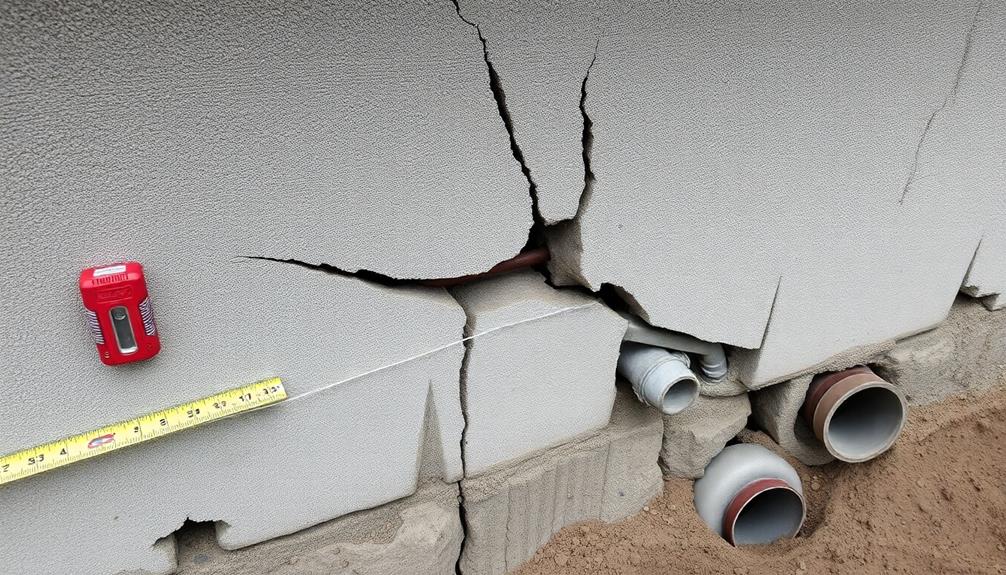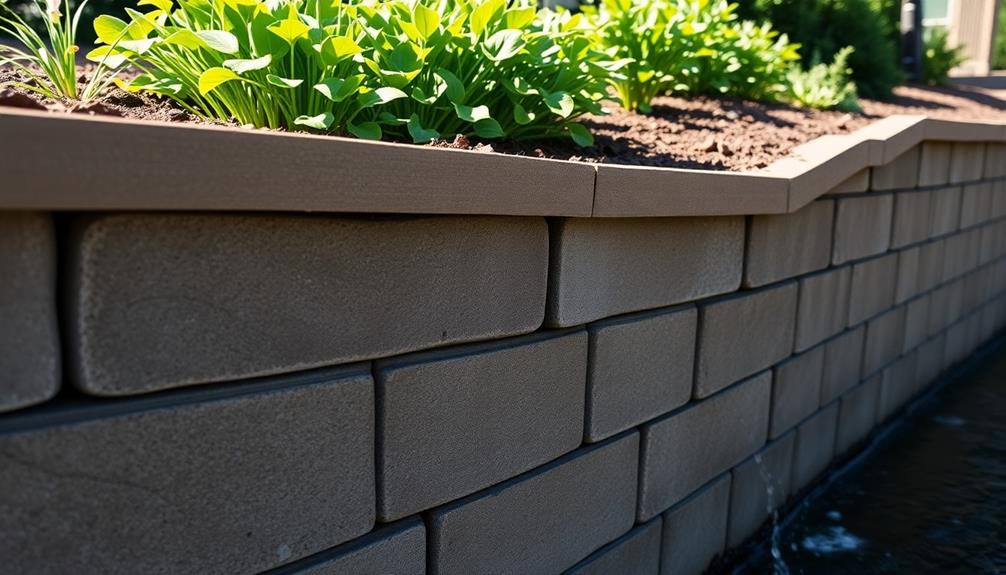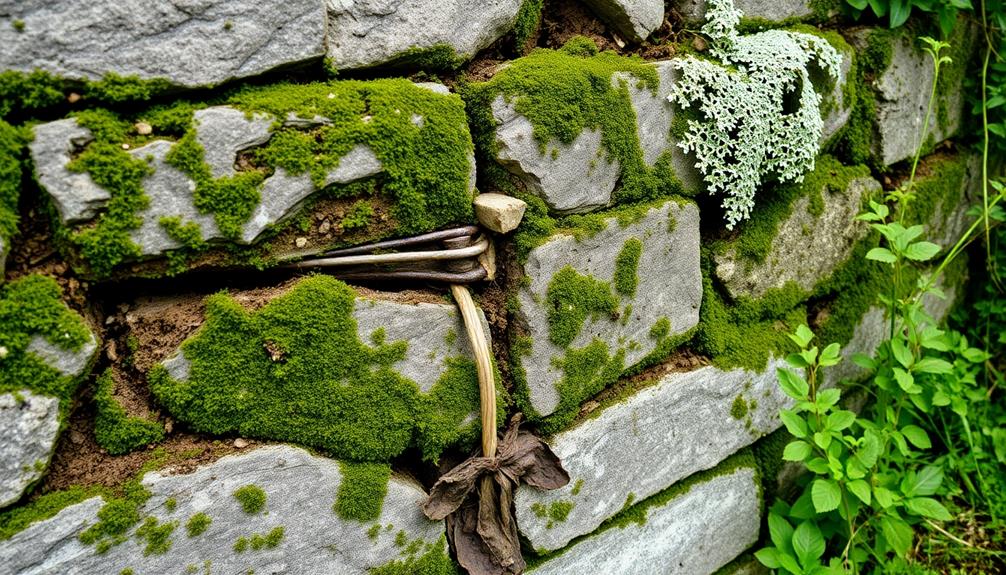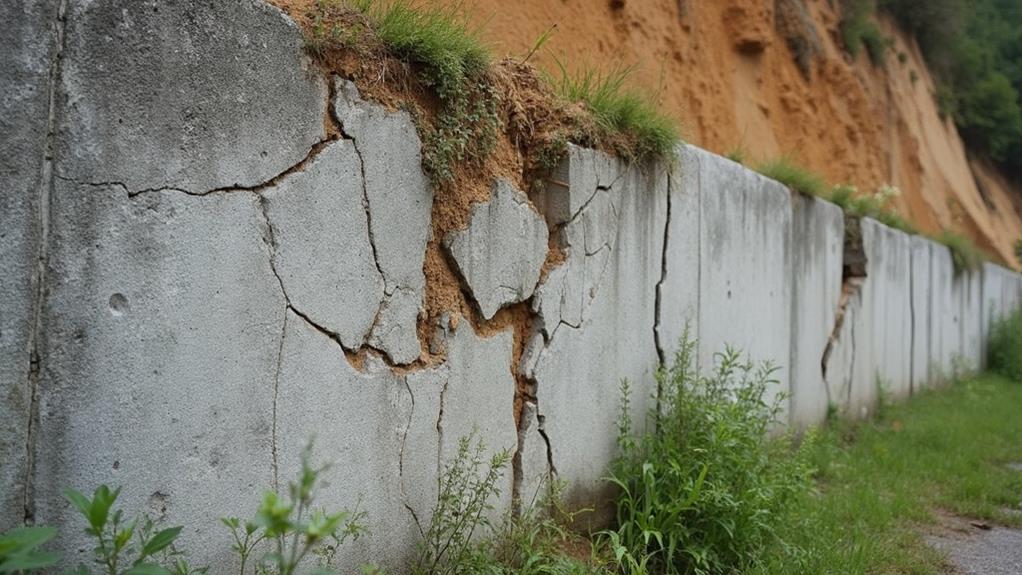When inspecting your retaining wall, focus on structural integrity and environmental impacts. Conduct a visual assessment for signs of bulging, leaning, or displacement, and examine the surface for cracks, spalling, or erosion. Evaluate drainage systems, including weep holes and grading, and assess joint conditions. Document any vegetation growth on or near the wall. Consider load-bearing capacity by analyzing soil pressure, foundation stability, and resistance to lateral earth pressures. Employ non-destructive testing methods to gauge material deterioration. Observe how environmental factors like moisture, temperature, and soil composition affect the wall's stability. A detailed inspection will reveal potential issues and necessary maintenance steps.
Table of Contents
ToggleWalls Contractor Highlights
- Check for visible cracks, bulges, or leaning in the wall structure.
- Examine drainage systems, including weep holes, for proper water management.
- Assess the condition of joints and look for signs of separation or deterioration.
- Inspect for vegetation growth on or near the wall that could impact its stability.
- Evaluate the soil conditions around the wall, including signs of erosion or settling.
Structural Integrity Assessment Process

The structural integrity assessment process for retaining walls encompasses several critical components that work in tandem to evaluate the wall's overall stability and performance. Visual inspection techniques form the foundation of this process, allowing engineers to identify surface defects, cracks, and other visible signs of distress that may indicate underlying structural issues.
Simultaneous evaluations of the wall's load-bearing capacity and material deterioration are conducted, utilizing advanced testing methods and analytical tools to quantify the wall's ability to withstand applied forces and assess the extent of degradation in its constituent materials over time. It's important to verify that the retaining walls meet the necessary building code requirements, which is a testament to the structural integrity and compliance to local regulations.
For walls built in areas prone to various weather conditions, specialized companies often emphasize the importance of weatherproofing and structural reinforcements, especially in places like the Twin Cities where these elements are critical.
Visual Inspection Techniques
Conducting a visual inspection forms the foundation of any retaining wall structural integrity assessment. This critical process involves a systematic examination of the wall's visible components, encompassing both the structure itself and its surrounding environment. Inspectors should begin by observing the overall alignment of the wall, looking for any signs of bulging, leaning, or displacement that may indicate underlying stability issues.
Careful attention must be paid to the wall's surface, noting any cracks, spalling, or erosion. These defects can provide valuable insights into the wall's condition and potential areas of concern. The inspection should also include an evaluation of drainage systems, as proper water management is essential for maintaining the wall's integrity. Observers should look for clogged or damaged weep holes, inadequate grading, or signs of water accumulation behind the wall.
Additionally, the condition of joints, if present, should be assessed for signs of deterioration or separation. Vegetation growth on or near the wall should be documented, as root systems can potentially compromise the structure's stability. By meticulously documenting these visual clues, inspectors can create an extensive picture of the retaining wall's current state and identify areas requiring further investigation or immediate attention.
Load-Bearing Capacity Evaluation
Every extensive retaining wall inspection must include a thorough evaluation of the structure's load-bearing capacity. This integral assessment determines the wall's ability to withstand the forces exerted upon it, ensuring the safety and longevity of the structure. As responsible property owners, we must prioritize this evaluation to protect our investments and the well-being of those in proximity to the wall.
The load-bearing capacity evaluation involves a series of sophisticated tests and calculations. Engineers employ advanced techniques such as soil pressure analysis, foundation stability assessments, and structural integrity examinations. These methods provide pivotal data on the wall's ability to resist lateral earth pressures, hydrostatic forces, and surcharge loads. Additionally, the evaluation considers factors such as material degradation, environmental influences, and potential design flaws that may compromise the wall's performance over time.
Material Deterioration Analysis
Integral to the structural integrity assessment process, material deterioration analysis plays a vital role in evaluating the overall health of retaining walls. This extensive examination focuses on identifying signs of wear, decay, and damage that may compromise the wall's ability to withstand lateral earth pressures and environmental stressors. By meticulously inspecting the retaining wall's components, engineers can detect early indicators of potential failure and recommend appropriate remediation strategies.
The material deterioration analysis typically involves:
- Visual inspection for cracks, spalling, efflorescence, and corrosion
- Non-destructive testing methods, such as ultrasonic pulse velocity and ground-penetrating radar
- Laboratory analysis of core samples to assess material properties and chemical composition
These techniques allow professionals to gauge the extent of degradation and its impact on the wall's structural integrity. By employing a systematic approach to material deterioration analysis, we can maintain the longevity and safety of retaining walls in our communities. This proactive stance not only protects property values but also safeguards the well-being of residents, fostering a sense of security and shared responsibility among homeowners and infrastructure managers alike.
Benefits

Regular inspection and maintenance of retaining walls offer numerous benefits that extend beyond structural stability. These advantages include increased property value through enhanced landscape aesthetics and the creation of additional usable space on sloped terrain.
For example, employing boulder walls can provide customizable dimensions and locations, enhancing the aesthetic appeal and functionality of your outdoor space. In addition, well-maintained retaining walls play a pivotal role in preventing soil erosion, thereby safeguarding the integrity of the surrounding landscape and protecting nearby structures from potential damage.
Improved Property Value
A well-maintained retaining wall can dramatically enhance property value. By providing structural support and aesthetic appeal, these walls contribute hugely to a property's overall worth.
Prospective buyers and appraisers often view well-constructed retaining walls as valuable assets, recognizing their role in preventing soil erosion, improving drainage, and creating usable space on sloped terrain.
To maximize the value-adding potential of your retaining wall, consider the following:
- Implement regular maintenance schedules to safeguard the wall's longevity and structural integrity
- Incorporate landscaping elements that complement the wall's design, such as tiered gardens or decorative plantings
- Choose high-quality materials that not only enhance durability but also elevate the aesthetic appeal of your property
Investing in professional inspections and timely repairs demonstrates a commitment to property upkeep, which resonates with potential buyers and real estate professionals.
A properly maintained retaining wall can transform challenging topography into an attractive feature, effectively increasing usable land and expanding outdoor living spaces. This practical enhancement often translates to a higher market value, positioning your property favorably in competitive real estate markets.
Enhanced Landscape Aesthetics
Retaining walls frequently serve as both functional and aesthetic elements in landscape design. These structures not only prevent soil erosion and create usable space but also considerably enhance the visual appeal of outdoor areas. When properly integrated into the landscape, retaining walls can transform an otherwise mundane terrain into an enthralling, multi-dimensional environment that adds character and charm to the property.
The aesthetic benefits of retaining walls are manifold. They can create striking visual interest by introducing varying levels and textures to the landscape. By incorporating materials that complement the existing architecture and natural surroundings, these walls seamlessly blend form and function. Well-designed retaining walls may feature decorative elements such as capstones, built-in planters, or integrated lighting, further elevating their aesthetic value.
Additionally, they provide opportunities for creative landscaping, allowing for the cultivation of tiered gardens, cascading water features, or strategically placed ornamental plants. The interplay of light and shadow on the wall's surface throughout the day can create dynamic visual effects, adding depth and intrigue to the outdoor space. Ultimately, a thoughtfully constructed retaining wall becomes an integral part of the landscape, enhancing its overall beauty and cohesiveness.
Increased Usable Space
Through the strategic implementation of retaining walls, property owners can dramatically expand their usable outdoor space. These structures effectively transform sloped or uneven terrain into level, functional areas, enabling homeowners to maximize their property's potential.
By creating terraced landscapes, retaining walls facilitate the development of additional outdoor living spaces, gardens, or recreational areas that were previously impractical or inaccessible.
The increased usable space provided by retaining walls offers numerous benefits:
- Enhanced property value through the creation of additional functional areas
- Improved accessibility to formerly challenging terrain
- Opportunities for creative landscaping and outdoor design solutions
Retaining walls not only solve topographical challenges but also present opportunities for innovative outdoor living concepts. Homeowners can utilize the newly created space for various purposes, such as installing patios, creating outdoor kitchens, or establishing vibrant garden beds.
This expansion of usable area fosters a sense of connection between indoor and outdoor spaces, allowing property owners to fully embrace and utilize their entire landscape. By investing in well-designed retaining walls, individuals can reveal the hidden potential of their property, creating a more inviting and versatile outdoor environment for themselves and their guests.
Soil Erosion Prevention
One of the primary benefits of retaining walls is their central role in preventing soil erosion. These structures act as a robust barrier against the natural forces that can gradually wear away the landscape, particularly on sloped terrain. By effectively holding soil in place, retaining walls mitigate the risk of landslides and protect the integrity of the surrounding environment.
When inspecting your retaining wall for its soil erosion prevention capabilities, pay close attention to the drainage systems in place. Proper water management is essential for the wall's effectiveness and longevity. Look for weep holes or drainage pipes that allow water to escape from behind the wall, reducing hydrostatic pressure. Additionally, examine the soil composition and compaction behind the wall, as these factors substantially influence its ability to resist erosion.
Regularly assess the wall's structural integrity, checking for any signs of bowing, cracking, or shifting. These issues could compromise the wall's ability to retain soil effectively. By maintaining your retaining wall and addressing any concerns promptly, you guarantee its continued performance in safeguarding your property against soil erosion, preserving both the aesthetic appeal and functional value of your landscape.
Environmental Impact on Materials

Environmental factors play a pivotal role in the longevity and performance of retaining wall materials. The interplay between moisture, temperature fluctuations, and soil composition can dramatically impact the structural integrity of these essential landscape elements. Additionally, the encroachment of plant roots and the pressure exerted by vegetation growth can exacerbate material degradation, necessitating regular inspections and maintenance to confirm the wall's continued effectiveness.
| Environmental Factor | Impact on Materials | Mitigation Strategies |
|---|---|---|
| Moisture | Erosion, corrosion, and freeze-thaw damage | Proper drainage systems, waterproofing |
| Temperature | Expansion and contraction, material fatigue | Expansion joints, temperature-resistant materials |
| Soil Composition | Chemical reactions, pressure distribution | Soil analysis, appropriate material selection |
| Plant Growth | Root intrusion, increased moisture retention | Regular pruning, root barriers |
Moisture and Temperature Effects
Moisture and temperature fluctuations profoundly impact the structural integrity and longevity of retaining walls. These environmental factors can lead to material degradation, structural weakening, and potential failure if not properly addressed. As responsible property owners, it's essential to understand how these elements affect our retaining walls and take appropriate measures to mitigate their impact.
When inspecting your retaining wall for moisture and temperature effects, consider the following key points:
- Look for signs of water damage, such as efflorescence (white, powdery deposits), discoloration, or moss growth, which may indicate excessive moisture penetration.
- Examine the wall for cracks or bulges, particularly after freeze-thaw cycles, as these can be indicators of internal stress caused by temperature fluctuations.
- Assess the drainage system's effectiveness, including weep holes and backfill material, to ensure proper water management and prevent hydrostatic pressure buildup.
Soil Composition Influence
The foundation upon which a retaining wall stands plays an essential role in its long-term stability and performance. The composition of the soil beneath and behind the wall significantly impacts its structural integrity and durability. Different soil types exhibit varying characteristics, such as compressibility, shear strength, and water retention capacity, which directly impact the wall's behavior under load and environmental stresses.
Clay soils, for instance, are known for their expansive properties, swelling when wet and shrinking when dry. This cyclical movement can exert substantial pressure on the retaining wall, potentially leading to cracks or displacement over time. Sandy soils, while generally more stable, may pose drainage challenges and require additional measures to prevent erosion. Loamy soils, a mixture of sand, silt, and clay, often provide a balanced foundation but still necessitate careful consideration of drainage and compaction.
When inspecting your retaining wall, it's imperative to assess the soil composition and its potential effects on the structure. Look for signs of soil movement, such as bulging or leaning in the wall, and evaluate the efficiency of drainage systems to mitigate soil-related issues.
Plant Growth Impact
While soil composition forms the foundation of a retaining wall's stability, vegetation growth in and around the structure can greatly impact its integrity over time. Plant roots can exert significant pressure on the wall, potentially leading to structural damage or displacement. Conversely, certain types of vegetation can contribute to soil stabilization, enhancing the wall's performance.
When inspecting your retaining wall, consider the following aspects of plant growth:
- Root penetration: Assess the extent of root systems infiltrating the wall structure, particularly for large trees or shrubs in close proximity.
- Soil erosion control: Evaluate the presence of ground cover plants that may help prevent soil erosion and maintain proper drainage.
- Moisture retention: Observe how vegetation affects soil moisture levels, as excessive moisture can lead to hydrostatic pressure and wall instability.
Understanding the interplay between plant growth and your retaining wall is essential for maintaining its structural integrity. Regular inspections should include careful observation of vegetation patterns and their potential effects on the wall's performance. By addressing plant-related issues promptly, you can extend the lifespan of your retaining wall and guarantee its continued effectiveness in supporting the surrounding landscape.
Walls Contractor FAQ
How Often Should I Inspect My Retaining Wall?
As fellow homeowners, we verify the significance of frequent upkeep. Inspect your retaining wall at least twice a year, typically in spring and fall. After severe weather events, it's wise to perform additional checks to safeguard our community's safety and aesthetics.
Can I Add Height to an Existing Retaining Wall?
Adding height to an existing retaining wall is possible, but it requires careful consideration. We recommend consulting a professional engineer to assess the wall's structural integrity and soil conditions. Together, we can determine the best approach for your specific situation.
What's the Average Lifespan of a Well-Maintained Retaining Wall?
The average lifespan of a well-maintained retaining wall varies depending on materials and construction quality. Generally, our community can expect 50-100 years for concrete or stone walls, while wood walls may last 20-30 years with proper care.
Are There Specific Insurance Considerations for Properties With Retaining Walls?
Yes, properties with retaining walls often require specialized coverage. Homeowners should consult their insurance providers to guarantee adequate protection against potential damages or liability issues. Many policies may need additional endorsements to fully cover retaining wall-related risks.
How Do I Choose the Right Professional for Retaining Wall Inspection?
To choose the right professional for retaining wall inspection, seek a licensed structural engineer or experienced contractor specializing in retaining walls. Look for credentials, positive reviews, and relevant experience. Ask for references and compare multiple quotes before making a decision.







